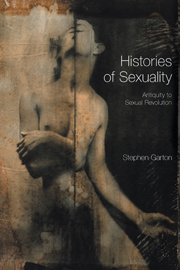Book contents
- Frontmatter
- Dedication
- Contents
- Preface
- 1 Writing Sexual History
- 2 Rule of the Phallus
- 3 Sexual Austerity
- 4 Christian Friendships
- 5 Making Heterosexuality
- 6 Victorianism
- 7 Dominance and Desire
- 8 Feminism and Friendship
- 9 Imagining Perversion
- 10 Normalizing Sexuality
- 11 Sexual Revolution
- Epilogue
- Endnotes
- Select Bibliography
- Index
Epilogue
- Frontmatter
- Dedication
- Contents
- Preface
- 1 Writing Sexual History
- 2 Rule of the Phallus
- 3 Sexual Austerity
- 4 Christian Friendships
- 5 Making Heterosexuality
- 6 Victorianism
- 7 Dominance and Desire
- 8 Feminism and Friendship
- 9 Imagining Perversion
- 10 Normalizing Sexuality
- 11 Sexual Revolution
- Epilogue
- Endnotes
- Select Bibliography
- Index
Summary
If by the late-twentieth century sexuality had become a major way men and women understood and marked their identity, would it continue to do so? An answer to that question depends in part on the historical narratives of sexuality that shape contemporary understandings of the interrelationships between sex and identity. Sex may be a biological drive but it is also a set of practices through which men and women shape and are shaped by culture. A careful examination of the history of sexuality suggests that sex has presented both possibilities and problems in many times and places. Sexual desire has been a way of cementing social bonds, asserting dominance and signifying status. It has also been seen as something that could unsettle the social order, a capacity that needed to be mastered, regulated and in some instances outlawed and punished.
For many historians the clash of instinct and culture suggests important continuities in the history of sexuality. This is most evident in the search for a gay and lesbian past. Historians have uncovered a rich history of same-sex practices across many times and places. Gay and lesbian history has attempted to uncover the contours of the struggle of homosexuals and lesbians to express desire and live in communities of those who share their passions. These efforts to enact sexuality are intimately linked to widespread concern about homosexuality. This type of love has been condemned, ridiculed, persecuted and punished.
- Type
- Chapter
- Information
- Histories of SexualityAntiquity to Sexual Revolution, pp. 229 - 233Publisher: Acumen PublishingPrint publication year: 2004



